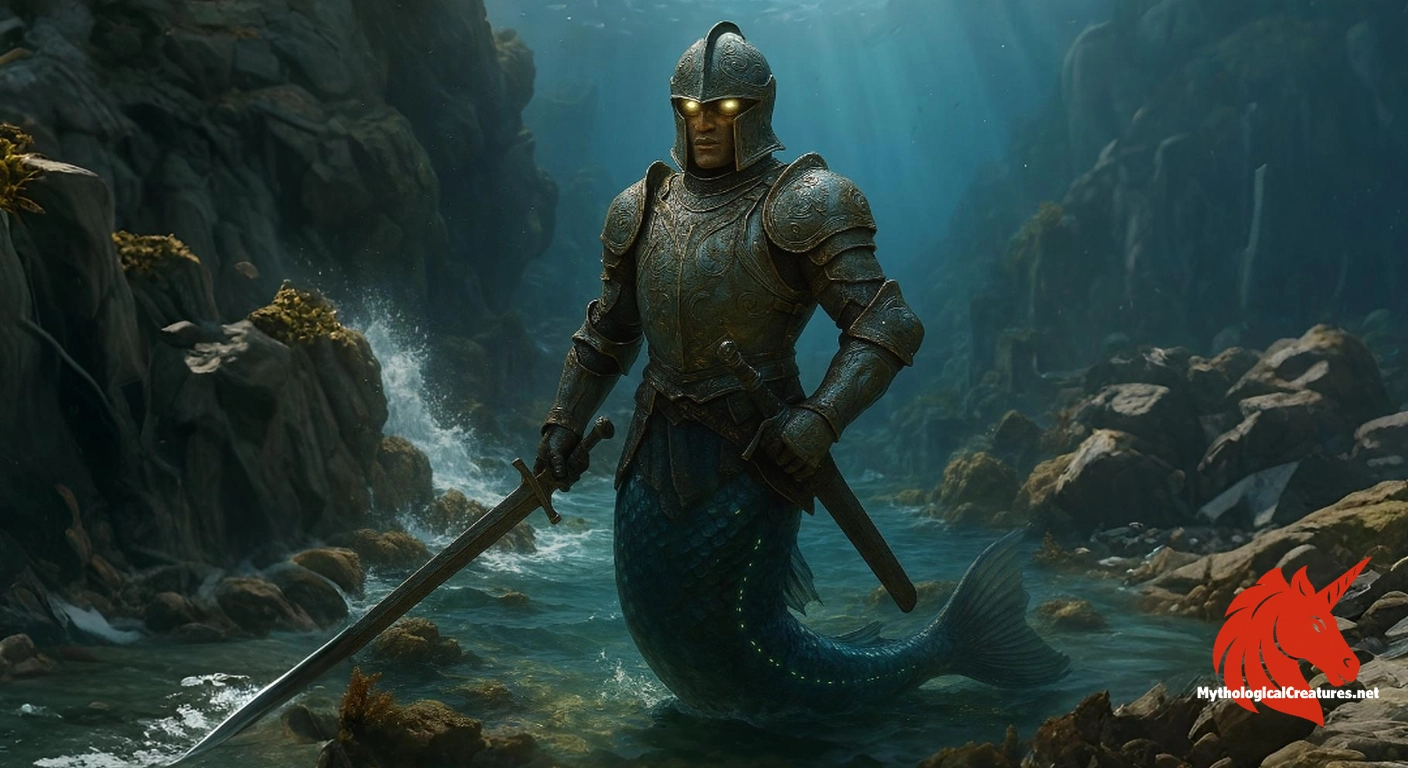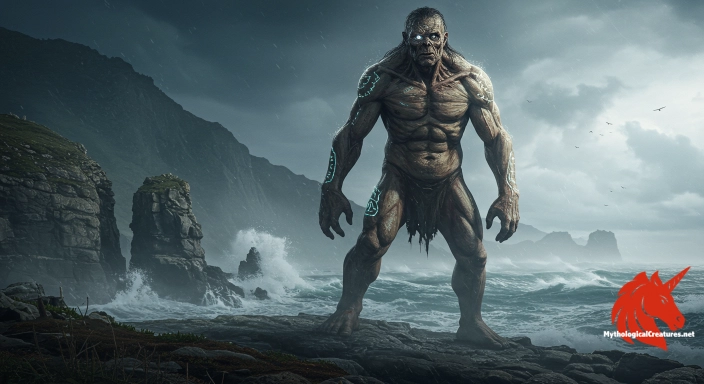Zitiron: The Zitiron is a mythological creature featuring the upper body of an armed knight and the lower body of a fish.

Zitiron
Zitiron - Represents the fusion of terrestrial chivalric virtues with the mystique of the ocean, serving as a protector and symbol of bravery at sea.
Origins & First Encounters
The Zitiron, often referred to as the sea knight, embodies a fascinating fusion of chivalric bravery and maritime mystery. Its origin appears to be rooted in a convergence of coastal folklore and medieval warrior ideals, making it a symbol of both honour and the capricious nature of the sea. Early narratives seem to have emerged among seafarers and coastal communities, where encounters with this enigmatic figure were woven into local legend. The creature is depicted with an upper body reminiscent of a well-armoured knight, complete with weaponry, which gradually transforms into the sleek tail of a powerful fish. This visual synthesis offers a compelling narrative of transformation, merging human nobility with the untamed spirit of the ocean. The first attested accounts, though fragmentary, suggest that the concept was used to explain mysterious events at sea and to instil respect for nature’s hidden forces. The tale of the Zitiron resonated across diverse socio-cultural landscapes, from isolated fishing villages to grand port cities, each embellishing its myth with unique details. Over time, the sea knight has captured the imagination of many, serving as a bridge between the rigid codes of chivalry and the unpredictable realm of the deep.
Source Texts & Tale Variants
Historical documentation of the Zitiron can be found in a variety of maritime texts and manuscripts, where its image was subtly referenced amid tales of supernatural intervention at sea. Ancient sailors’ journals and coastal folklore often mention a mysterious knight emerging from the water, a narrative that contributed to its mythic status. Some medieval accounts hint at divine interpretations, suggesting that the creature might have been seen as an envoy of the ocean’s spirits. Oral traditions, passed down through generations, have embellished the sighting of the sea knight with tales of both protection and retribution. In many coastal communities, the Zitiron was regarded as a mystical guardian whose appearance foretold changes in the weather or the fortunes of fishermen. Detailed descriptions, though sparse, have found their way into isolated texts and local carvings, adding layers of complexity to its legend. The creature’s story evolved in tandem with the growth of maritime exploration, with various regions offering their own unique versions of the narrative. Each variant, whether portraying the Zitiron as benevolent or foreboding, adds to the enduring mystique that surrounds this hybrid being. The blending of scholarly references with oral history has ensured that the myth of the Zitiron remains both elusive and intriguing.
Form & Powers
The physical form of the Zitiron strikes a dramatic balance between human knightly aesthetics and the fluid, dynamic nature of marine life. Its upper body is clad in meticulously detailed armour that appears as though it has withstood countless battles and the corrosive touch of salt water. This armour is often illustrated with intricate engravings that echo the art of medieval metalwork, complete with a poised profile and an expression of resolute determination. As the form descends, the structured design gradually dissolves into the elegant, streamlined tail of a large fish, covered in iridescent scales that shimmer with a spectrum of deep blues and vibrant greens. The creature’s anatomy suggests both physical strength and agility, with a tail that conveys the power to glide through the surging currents. Fine details such as conical fins and subtle patterns on the armour enhance its dual identity, merging the crafted human element with natural aquatic beauty. Artistic depictions frequently vary in size, with some illustrations presenting a colossal guardian of the deep, while others suggest a more delicate, almost ethereal presence. Overall, every element of its design—from the gleam of its metal to the reflective quality of its scales—reinforces a sense of mystery and timeless allure.
Regional Faces
Across various coastal regions, the legend of the Zitiron has been moulded by local maritime traditions and environmental realities. In the cooler climes of Northern Europe, it is sometimes portrayed with an almost spectral quality, its features tinged with the pallour of icy waters and long winter nights. In contrast, Mediterranean renditions imbue the sea knight with a sun-dappled aura, often emphasising noble attributes and a radiant, almost heroic presence. British Isles folklore occasionally intertwines the creature with elements of faerie lore, adding a layer of enchantment to its already complex persona. Along the rugged Atlantic coasts, eyewitness accounts describe it as a translucent figure emerging amid stormy seas, lending a supernatural quality to its myth. Some island communities see the Zitiron as a benevolent guardian, protecting their fishermen and warning them of impending tempests. Other regions have adopted a darker interpretation, where the creature serves as an omen of tragic misfortune or revenge from the deep. Local artistic and oral traditions have, over time, adjusted details such as the ornamental motifs on its armour or the texture of its scales to better reflect regional aesthetics. These diverse portrayals reinforce the adaptability of the myth and its resonance with the unique cultural climates of coastal societies.
Cultural Parallels
The Zitiron occupies a unique position in the tapestry of myth, drawing intriguing parallels with other hybrid creatures found in global folklore. It shares similarities with classical sea beings such as the hippocampus and tritons, which also blend human-like traits with the essence of the ocean. This confluence of chivalric imagery and marine symbolism echoes motifs seen in various cultures, ranging from the mysterious mermaids of ancient lore to the noble warriors of legendary epics. In Celtic traditions, creatures that straddle the line between human form and elemental force similarly serve as both protectors and portents of nature’s power. The integration of martial elements with aquatic grace sets the Zitiron apart, differentiating it from tales focused solely on seduction or danger, as is common in other merfolk legends. Comparative studies reveal that many hybrid myths, like that of the Zitiron, serve as metaphors for the duality of human nature and the unpredictable character of natural forces. While some cultures view such beings as heralds of doom, others celebrate them as symbols of transformation and resilience. The recurring theme of blending disparate worlds underscores a universal preoccupation with the liminal space between civilization and the wild. The Zitiron’s hybrid form continues to inspire cross-cultural dialogue, inviting comparisons that enrich our understanding of myth as a dynamic and evolving art form.
Legacy & Modern Evolution
The evolution of the Zitiron from a shadowy maritime legend to a celebrated figure in modern myth illustrates its enduring appeal. Early depictions, rooted in mysterious seafaring encounters, often portrayed the sea knight as an ambiguous entity balancing benevolence with latent menace. As time progressed, the image of the Zitiron underwent a transformation that paralleled societal shifts in attitudes towards nature and heroism. During the Renaissance and later periods, artistic representations began to emphasise realistic armour and anatomically inspired features, merging the fantastical with emerging scientific curiosity. In contemporary culture, the Zitiron has found a new home in literature, film, and video games where it is often reinvented as a guardian figure or a heroic antihero confronting elemental chaos. Modern interpretations frequently highlight its role as a bridge between the rational world of man and the unpredictable forces of the natural world. The creature’s image is celebrated in a variety of media, from detailed digital art to imaginative festival costumes at maritime events. This enduring legacy is a testament to its capacity to capture the imagination, reflecting changing cultural values while retaining its mythic core. As reinterpretations continue to emerge, the Zitiron remains a potent symbol of transformation, resilience, and the timeless allure of the unknown.
Interesting Fact
The Zitiron uniquely blends the valor of a knight with the enigmatic qualities of marine life, making it a rare example of a hybrid mythological entity that bridges two distinct worlds.
Quick Creature Info
Features:
Associations:
Our Mythic Legendary Rating:

Also Sometimes Known As:
Habitat:
Supernatural Powers:
Physical Attributes:
Abilities:
Behavior:
Lore:
References
Discover Another Mythical Legend You May Not Have Heard Of?
Uncover the mysteries of ancient folklore and expand your knowledge of legendary beings from cultures around the world.
Dare to Meet the Fomorians....
Curated by the Mythological Creatures Team (rev. May 2025)
